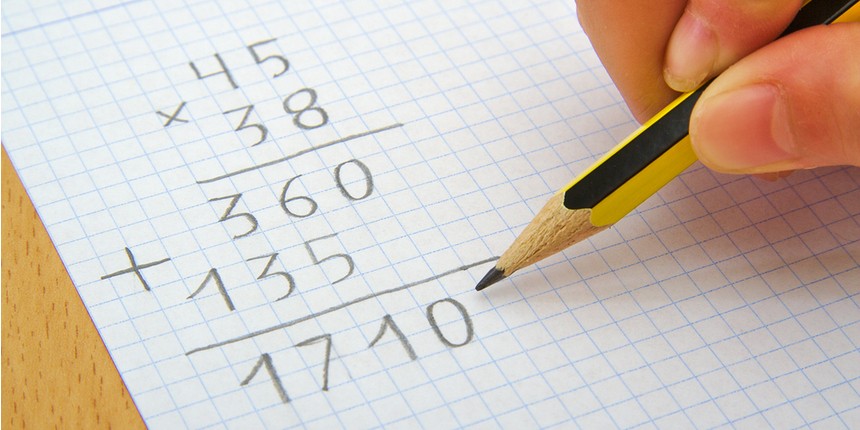Tallentex 2025 - ALLEN's Talent Encouragement Exam
ApplyRegister for Tallentex '25 - One of The Biggest Talent Encouragement Exam
NCERT Syllabus for Class 10 Maths 2024 - Students can refer to this NCERT Class 10 Maths syllabus 2024 to prepare for CBSE class 10th exam and other board exams. The NCERT 10th class Maths syllabus 2024 is devised by experts as per the level of CBSE 10th class students. NCERT syllabus for Class 10 Maths 2024 comprises topics and chapters that will be a part of the CBSE curriculum 2024.

The topics incorporated in the NCERT 10th Maths syllabus 2024 range from basic level to advanced level, which makes NCERT syllabus easy to understand. NCERT syllabus for Class 10 Maths 2024 is divided into sections such as - Algebra, Trigonometry, Geometry, etc. NCERT Class 10 Maths books are devised as per the prescribed syllabus given below. All CBSE affiliated schools follow the NCERT syllabus 2024. This article on class 10 NCERT maths syllabus 2024 mentions all the chapters and topics to be covered.
The table below mentions all the chapters and topics covered in NCERT 10th class maths syllabus 2024. Students must go through the same to know the topics to study in the 10th class. They can download NCERT 10th class Maths solutions to know the answer to any question.
| Chapter Name | Sections |
| Real Numbers | 1.1 Introduction 1 1.2 The Fundamental Theorem of Arithmetic 1.3 Revisiting Irrational Numbers 1.4 Summary |
| Polynomials | 2.1 Introduction 2.2 Geometrical Meaning of the Zeroes of a Polynomial 2.3 Relationship between Zeroes and Coefficients of a Polynomial 2.4 Summary |
| Pair of Linear Equations in Two Variables | 3.1 Introduction 3.2 Graphical Method of Solution of a Pair of Linear Equations 3.3 Algebraic Methods of Solving a Pair of Linear Equations 3.3.1 Substitution Method 3.3.2 Elimination Method 3.4 Summary |
| Quadratic Equations | 4.1 Introduction 4.2 Quadratic Equations 4.3 Solution of a Quadratic Equation by Factorisation 4.4 Nature of Roots 4.5 Summary |
| Arithmetic Progressions | 5.1 Introduction 5.2 Arithmetic Progressions 5.3 nth Term of an AP 5.4 Sum of First n Terms of an AP 5.5 Summary |
| Triangles | 6.1 Introduction 6.2 Similar Figures 6.3 Similarity of Triangles 6.4 Criteria for Similarity of Triangles 6.5 Summary |
| Coordinate Geometry | 7.1 Introduction 7.2 Distance Formula 7.3 Section Formula 7.4 Summary |
| Introduction to Trigonometry | 8.1 Introduction 8.2 Trigonometric Ratios 8.3 Trigonometric Ratios of Some Specific Angles 8.4 Trigonometric Identities 8.5 Summary |
| Some Applications of Trigonometry | 9.1 Heights and Distances 9.2 Summary |
| Circles | 10.1 Introduction 10.2 Tangent to a Circle 10.3 Number of Tangents from a Point on a Circle 10.4 Summary |
| Areas Related to Circles | 11.1 Areas of Sector and Segment of a Circle 11.2 Summary |
| Surface Areas and Volumes | 12.1 Introduction 12.2 Surface Area of a Combination of Solids 12.3 Volume of a Combination of Solids 12.4 Summary |
| Statistics | 13.1 Introduction 13.2 Mean of Grouped Data 13.3 Mode of Grouped Data 13.4 Median of Grouped Data 13.5 Summary |
| 14.1 Probability — A Theoretical Approach 14.2 Summary |
Here are the simple steps to download NCERT 10th class Maths syllabus as a PDF file from the official website:
Visit the NCERT official website: ncert.nic.in.
Click on the link of the syllabus and open the link of the secondary and higher secondary level syllabus.
It will lead to the zip file. Open the same and click on the NCERT syllabus for class 10 maths pdf.
Now scroll down and check the NCERT class 10 maths syllabus in the file.
Also read,
Syllabus Name | Download Link |
10th class NCERT Maths syllabus & guidelines | |
English medium syllabus | |
Hindi medium syllabus | |
Urdu medium syllabus |
Unit | Marks |
Number systems | 6 |
Algebra | 20 |
Coordinate geometry | 6 |
Geometry | 15 |
Trigonometry | 12 |
Mensuration | 10 |
Statistics and Probability | 11 |
Along with the NCERT syllabus for class 10 Maths, students should refer to the syllabus for other subjects:
After analyzing NCERT syllabus for class 10 Maths, students should read the books for maths and other all subjects. They can download the NCERT class 10 books using the links given here:
As per weightage in CBSE 10th exam 2024, Trigonometry, Geometry and Algebra are the important topics of the NCERT syllabus for class 10 Maths.
Yes, students can use NCERT 10th Maths syllabus to prepare for national level scholarship exams as well.
NCERT class 10 Maths syllabus difficulty level is moderate and topics range from basic to advanced level.
Late Fee Application Date:22 July,2024 - 31 July,2024
Late Fee Application Date:22 July,2024 - 31 July,2024

Register for Tallentex '25 - One of The Biggest Talent Encouragement Exam

Get up to 90% scholarship on NEET, JEE & Foundation courses

As per latest 2024 syllabus. Physics formulas, equations, & laws of class 11 & 12th chapters

As per latest 2024 syllabus. Chemistry formulas, equations, & laws of class 11 & 12th chapters

Accepted by more than 11,000 universities in over 150 countries worldwide

Register now for PTE & Save 5% on English Proficiency Tests with ApplyShop Gift Cards